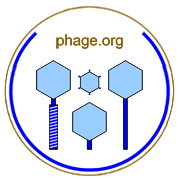

Post genome uptake into a now phage-infected bacterium, a temperate phage must literally choose between displaying two distinct life styles: productive versus reductive.
That is, a decision between a lytic cycle and a lysogenic cycle. The regulatory mechanisms underlying the lytic-lysogeny decision can be described as giving rise to a bistable switch. The molecular details of this mechanism are best worked out for the temperate phage, lambda (λ).
Under certain circumstances the lytic-lysogeny decision is biased towards lysogenic cycles, such as when multiplicities of phage adsorption per infected bacterium are somewhat higher than one. In these instances, it is a reasonable ecological inference that other bacteria are locally experiencing similar levels of phage infection and therefore that bacteria which are susceptible to the phage in question are declining in density within the environment (i.e., as due to phage infection).
Under these circumstances, lysogeny would appear to be the preferred strategy, as consistent with the so-called "hard times" hypothesis. By contrast, when uninfected bacteria are abundant then lytic infections along with subsequent production of phage-virion progeny would appear to be the more advantageous strategy since acquisition of new, uninfected bacteria is dependent upon phages displaying productive infections. Key is to have a mechanism that both allows for a choice in infection strategies upon adsorption and, ideally, one which also can be biased towards more ecologically favorable decisions, which indeed appears to be what occurs with phage λ lytic-lysogeny decisions.
In bacteriophage λ the lytic-lysogeny decision is dependent on levels of the lambda protein CII that are found within infected bacterium. High levels results in little production of the CI repressor and consequently a lytic cycle. Lower levels of CII, by contrast, allow CI production and a resulting tripping of the switch to a lysogenic cycle. The actual lytic-lysogeny decision is made quite far into the lambda infection, though, occurring after about 10 min under typical laboratory growth conditions. Factors that seem to bias the lytic-lysogeny decision for phage lambda towards lysogeny include lower temperatures, less nutrient-rich (or simply "poorer") media, or high multiplicities of phage adsorption.
Though not necessarily universally appreciated, in fact most lytic-lysogeny decisions, at least in the laboratory, seem to result in lytic cycles rather than lysogenic cycles. In other words, temperate phages in many instances can be viewed first as lytic phages and only relatively rarely do they display lysogenic cycles. To a degree this makes sense ecologically since the fact that a phage has found a bacterium is, on average, consistent with a potential for the virion progeny of those phages to also find a bacterium to successfully infect.
For reviews providing discussion of the lytic-lysogeny decision, see Little (2005), Ptashne (2004), etc.
For more on this topic, see Wikipedia, Google, and PubMed. Contact web master. Return to terms.